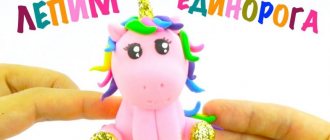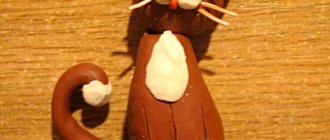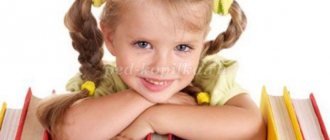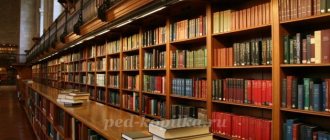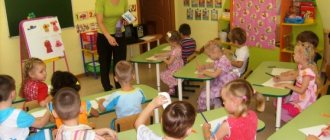Lesson summary for the middle group “A book is your best friend”
Summary of a conversation with children “The book is our good friend” for children of the middle group.
Author: Vitskova Marina Viktorovna, teacher of the MBDOU “Kindergarten “Golden Fish” of the Astrakhan region, Chernoyarsk district. This material will be useful for educators when conducting thematic conversations with children of middle preschool age. Goal: to cultivate love and respect for books, develop interest, the need for reading, and respect for books. Objectives: 1. Develop a sustainable interest in the book, its design, illustrations. 2. Enrich children's understanding of the variety of books. 3. Reinforce the rules of cultural handling of books.
Progress of the conversation
“Hello” The greeting is accompanied by movements, the children sit on the carpet in a circle: Hello, Heaven!
Raise your hands up
Hello, Sun!
Make a large circle with your hands above your head.
Hello, Earth!
Smoothly lower your hands onto the carpet
Hello, planet Earth!
Describe a large circle above your head
Hello, our big family!
All the guys join hands and raise them up. Educator. Guys, guess the riddle and then you will find out what we will talk about. Mystery. There is a leaf, there is a spine. Not a bush or a flower. No paws, no hands. And he comes to the house as a friend. He'll lie on mom's lap and tell you everything. Children. This is the book Educator. That's right, you guessed it. Well done! Today we will talk to you about the books Educator. Guys, look, we have a lot of different books on our bookshelf in our group! In the book hall there are books in a row, all on the shelves. Children come to visit them and here they find knowledge. Please look at them and tell me if all the books are the same or not? (children's answers) Educator. Tell me, children, who writes children's books? Children. Children's writers. Educator. Guys, what children's writers do you know? Children. K.I. Chukovsky, P.P. Bazhov, A.L. Barto, V.V. Bianchi, S.Ya. Marshak, E.I. Charushin Educator. Children, why do you think we need books? Children. We need books to read, learn something new and interesting, and look at pictures.
Physical school is being held
Open the book quickly!
Spread your arms to the sides. In the book, there is a midge, a mouse, a bear, according to the text. In the book, the ball is round on its side, Up, down, jump, hop. There is an umbrella in the book, open it and sing, Raise your hands up above your head. The rain is pouring, but you are dry! Fingers on the knees Pussy in the book close - close Stroking hands. In the color picture, I stroke the pussy with my hand for a long time - After all, the fur of the pussy is such a teacher. Children, what does the book consist of? What does the book have? Children. The book has pages that consist of sheets of paper Educator. Well done, that's right, guys, touch the book with your hands, run your hands along the page. What are they? Children. They are paper Educator. Can paper tear, children? Children. Yes, Educator. Crumple the paper into a ball and tear it. What's happening? (Children's answers) Educator. The pages of a book can just as easily become wrinkled if you handle them carelessly. Guys, how should you handle a book correctly? Children. You should not take books with dirty hands, you should not draw on them, you should not tear out pages, you should not read a book while eating. Educator. Guys, do you go to the library to buy books? What books do you buy there? Who reads them to you? (Children's answers) Educator. Now, guys, let's put all the books on the bookshelf. Today we looked at books, found out how many different books exist in our lives, put them in their places, and fixed the rules for using books. You guys are great, you were very good conversationalists. Educator. The book is your best friend, I am so happy with you! I love reading you, thinking, contemplating and dreaming!
We recommend watching:
Summary of educational activities for children with parents in the middle group. Do-it-yourself doll Summary of a lesson on speech development on the topic “Toys” in the middle group Methodological development of GCD for the development of communicative activities in children of the middle group Synopsis of a game lesson in mathematics in the middle group of a preschool educational institution
Similar articles:
Lesson in the middle group “Winter clothes”
Math lesson notes “Number 1”. Middle group
Child-parent project “Children’s Book Week” in the middle group
Bibliographic description:
Klementyeva, E. E. Child-parent project “Children’s Book Week” in the middle group / E. E. Klementyeva. — Text: direct // Questions of preschool pedagogy. — 2021. — No. 5 (15). — P. 86-89. — URL: https://moluch.ru/th/1/archive/100/3540/ (access date: 12/19/2021).
Childhood... The time of the most vivid impressions, the deepest experiences, the most amazing - first - encounters with this world. Every child's acquaintance with literature begins with short poems, nursery rhymes, and Russian folk tales, which accompany his entire childhood and remain with him throughout his life.
Children's fiction, being a treasury of spiritual wealth for children and adults, makes it possible to compensate for the lack of communication between preschoolers and people around them, broaden their horizons, and enrich their life and moral experience. Literary works involve students in thinking about the actions and behavior of people and current events; encourage their evaluation and enrich the emotional sphere.
A child, immersing himself in a fairy-tale world, ascends both to the level of already mastered sociocultural material, and to the level of something not yet known by humanity (“the image of the needed future”).
In a fairy tale there are always indirect indications of points of growth of human capabilities and abilities. Penetrating through a fairy tale into the thickness of the cultural and historical layers of human development, the child acquires a creative vector, and his individual creative potential as a future active reader increases.
Raising a future reader is a long and difficult process, but if the initial stage of introducing a child into book culture is successful, then the number of young people who are unable or unwilling to join the spiritual experience of humanity through books will be significantly reduced.
Relevance of the problem.
A decrease in reader interest, on the one hand, and the obviousness that reading in the modern world is an essential component of life success, on the other hand.
The goal of the project: to introduce children and their parents to reading children's fiction.
Project objectives:
– to develop an interest in books and children’s reading, to acquire a stock of literary artistic impressions and listener experience;
– develop cognitive, creative and emotional activity in the process of introducing preschoolers to literature;
– broaden children’s horizons, enrich and activate their vocabulary;
– develop children’s basic design and creative abilities by involving them in the design of homemade books for kids;
– cultivate a value-based attitude towards a book as a work of art;
– involve parents in creating conditions for developing children’s interest in books at home and in kindergarten, and revive reading within the family.
Preliminary work with children:
– thematic design of a group room;
– drawing together with parents the characters of your favorite fairy tales;
– reading children's fairy tales, stories, poems;
– selection of poems and preparation of expressive reading for memorization;
– selection of portraits of children's poets and writers.
Type, type of project : short-term.
Participants: middle school children, parents, teachers.
Final event: presentation of homemade books to younger preschoolers.
Expected result.
– Acquaintance with fairy tales will develop the first moral standards in middle preschoolers, and step by step will form an interest and love for literature.
– Children’s horizons will expand, their vocabulary will be enriched and activated.
– Family reading will be revived.
With the development of various modern technologies of smartphones, tablets, and computers, a book has ceased to be an important subject not only in the lives of preschool children, but also of their parents. Not so long ago, a book was considered the best gift for every child; now its place has been taken by technology and all kinds of electronic toys. The tradition of home reading, unfortunately, has faded into oblivion.
Children's book week in the middle group was divided into five topics.
Monday is fairy tale day. Opening of “Book Week”. The group organized a thematic book exhibition. The children got acquainted with the exhibition, looked at the books, and remembered familiar Russian folk tales “Sister Alyonushka and Brother Ivanushka”, “The Zhikharka”, “The Cockerel and the Bean Seed”, as well as fairy tales by V. G. Suteev, S. Mikhalkov, the Brothers Grimm, Sh. Perrault, K, Chukovsky. We learned new games: “Body with fairy tales”, “Guess the fairy tale”. We held a quiz “Journey through Fairy Tales”.
On Tuesday, on the day of book experts, we introduced the children to the history of the book, talked about the rules for handling it, looked at book covers, learned what illustration, literary text, binding, page are, and became acquainted with the concept of printing house, library. We thought about the topic: “Why do we need books?”
On Wednesday, on the day of the game and theater “We are playing a fairy tale,” theatrical and play activities were organized in the group at the request of the children, conditions were created for independent creativity in the game using the “Ramming” corner. By coincidence, on this day artists from the Samara Philharmonic came to our kindergarten. Our children enjoyed watching the children's performance. Children consolidated such concepts as theater, performance, stage, artists, spectator. In the afternoon, the role-playing game “In the Bookstore” was played.
On the day of creativity “We do it ourselves - with our own hands,” the children and I tried to illustrate a fairy tale, and although our illustrations were not entirely successful, our drawing skills failed us, the children were very pleased with their creative result. After sleep, work was organized to repair old books in the corner of the “Knizhkina Hospital”.
On the closing day of Children's Book Week, children brought homemade books for children, made together with their parents, and looked at and discussed them with great interest. And after breakfast there was a presentation of the books made to the children of the group.
Event plan
| Theme of the day | Operating procedure | Children's activities | Activities of educators | Parents' activities |
| Monday Day fairy tales "There are many fairy tales in the world..." | Opening of “Book Week”. Design of a thematic book exhibition in a group. Work in the book corner. | Conversation “Rules for handling a book.” Learning games: “Body with fairy tales”, “Guess the fairy tale”. Collaborative and independent games with table theaters. Looking at illustrations in books. | Design and review of the exhibition of methodological literature, Teacher’s story “The History of the Book” - A teacher’s story about the development of writing with illustrations. | Consultation "Theater on the kitchen table." Read the leaflet “Instilling in Children a Love of Reading.” |
| Tuesday "Day of Book Experts" | Educational lesson “Such different books.” A conversation about the rules of handling a book. | Participation in the quiz “Journey through Fairy Tales”. "These funny animals." Reading and listening to fairy tales, stories, poems, riddles about animals, works by E. Charushin, V. Suteev, V. Bianki, S. Marshak, K. Chukovsky. | Design of the memo “Introducing preschoolers to fiction.” Design of a card index of didactic games, selection of works of art on the topic. Design of a thematic book exhibition. | Participation in the quiz. Assisting in creating conditions for theatrical and role-playing games (production of the necessary attributes). |
| Wednesday theater day "We are playing a fairy tale" | Organization of theatrical and play activities for children, creation of conditions for children’s independent creativity in play. | Role-playing game “In a bookstore.” Dramatizations of your favorite fairy tales. Theatrical and role-playing games at the request of children. Listening to Russian folk tales. | Design of the memo “Introducing preschoolers to fiction.” Design of a card index of didactic games, selection of works of art. | Consultation “So that the fairy tale does not become boring.” Tips for decorating a children's home library “Books in our house.” |
| Thursday Creativity Day “We do it ourselves —with our own hands.” | “Knizhkina Hospital” - organization of work on the repair of old books. Organization of children's productive activities based on literary works. Exhibition of works of joint creativity “We do it ourselves - with our own hands.” | Organization of work in the “Knizhnik Hospital” corner. The plot is a role-playing game “Book Hospital”. S/r game “Book Publishers” - Drawing, modeling, appliqué based on the plots of literary works “My Favorite Fairy Tale”, “Portrait of a Fairy-tale Hero”, “Amusing Town”. | Teacher's story «A journey through the shelf of smart books." Design of the booklet “For parents - about children's reading.” | Consultation “What and how to read at home?”, “Children’s reading circle.” Making homemade books is a joint creativity of parents and children. Participation in the creative exhibition “We do it ourselves - with our own hands.” |
| Friday Closing day of Children's Book Week. | Presentation of a group book corner, book exhibition. Summing up the results of Children's Book Week. | S/r game "Library". Presentation of homemade books for younger preschoolers. | Preparation for the presentation of homemade books to younger preschoolers. | Creation of a creative group to produce the thematic magazine “The Book of Our Childhood.” |
| Closing of Children's Book Week. | ||||
Result of the project:
– got acquainted with the works of children's writers;
– remembered Russian folk tales;
– the horizons have expanded, the vocabulary has been activated when familiarizing yourself with illustrations of children's books (cover, binding, illustration, typography, font, letters, etc.);
– the rudiments of children’s elementary design and creative abilities were formed by involving them in the design of homemade books for kids;
– systematic home reading to a child at night formed the preschooler’s habit of daily communication with a book, developed an interest in children’s fiction, and brought all family members together.
Future plans.
– Continue to work on developing our students’ interest in books and children’s reading, acquiring a stock of literary artistic impressions and listener experience.
– With the help of parents, replenish the group’s book corner with new illustrated editions of their favorite books.
– Visit the children's district library.
Literature:
- Thematic weeks in kindergarten /Auth.-comp. T. N. Sergeeva. - M.: Planeta, 2013. - 128 p. - (Preschool education)
Key terms
(automatically generated)
: fairy tale, children's book, book, child, day, children's reading, game, children's fiction, presentation of homemade books, creation of conditions.
Project for the middle group “Book Week”
Elena Sidorova
Project for the middle group “Book Week”
Educational project “Book Week”
(best to coincide with April 2nd. “International Children’s Book Day” and H.H. Anderson’s birthday)
Author of the project: Elena Albertovna Sidorova, teacher of GBDOU No. 31
Venue: St. Petersburg, GBDOU No. 31, Primorsky district, middle group “Bells”
Project duration: 1 week; from 28.03. — April 1, 2016
Type, type of project: short-term, group, research and creative.
Project participants: children of the middle group (children 4-5 years old, teachers, parents of students.
Relevance of the project: In the modern world, with the advent of computers, tablets, and other gadgets, interest in books is falling every day. Modern children have insufficient understanding of the book, its importance in human life, and of the book as an irreplaceable source of knowledge. The consequence of insufficient communication between children and books are speech disorders, poor vocabulary, and difficulties in composing stories. The participation of children in the “Book Week” project will allow them to maximally enrich their knowledge and ideas about the book, its significance, and develop coherent speech and children’s creative abilities. It is very important to show that a book is a faithful friend and an irreplaceable source of knowledge for children and adults.
The goal of the project: to clarify children’s knowledge about books, to increase interest in books. Develop cognitive interest, mental activity, imagination, creativity. Develop the ability to work in a team, the desire to share information, participate in joint creative activities, and make children want to communicate more with books.
Project objectives:
1. Activate children's cognitive interest.
2. Enrich ideas about the work of writers and illustrators.
3. Cultivate a love for books and a caring attitude towards them.
4. To form in children an understanding that a book is the main source of knowledge
5. Arouse positive emotions when reading a book, interest.
6. Involve parents in joint activities (visiting an excursion)
Preparatory stage.
Preliminary work:
themed design of a group room,
replenishment of corners: book corner (books of various contents, purposes, designs, art corner (different types of materials for creating baby books)
reading children's fairy tales, stories, poems,
selection of books for the “book workshop”
selection of illustrative material to introduce children to the artists whose works are featured in the books.
selection of portraits of poets and writers.
informing parents about the project.
Attributes and inventory:
portraits of children's writers,
portraits of writers - storytellers,
cut pictures, puzzles “My favorite fairy tales”,
colored cardboard, colored paper, corrugated paper, self-adhesive paper, scissors, glue,
recommendations for parents,
illustrations with characters from your favorite fairy tales, stories, poems.
Project implementation stages
Before the Book Week, a developmental environment was created in the group. Exhibitions of books on the following topics were organized: “Smart Books”, “Little Books”, “Magic Fairy Tales”, “My Favorite Book”, a long-term plan of activities for continuous educational activities was drawn up; a conversation was held about the upcoming event.
As part of the project, children and parents were offered:
- Choose your favorite book at home and write a story about it.
— Collect books at home and from friends that require repair.
Final event: excursion for children with their parents to the library.
Project implementation:
GCD for the project:
Lesson to familiarize yourself with the world around us “Journey into the past of the book.”
Lesson on speech development “The book is sick”;
Lesson on designing a “Baby Book”;
Visual arts lesson “Bookmarks”
Reading fiction:
Reading the work “Cat's House”, “Fire” by S. Ya. Marshak.
A journey through the exhibition “Funny Poems” (based on the poems of S. Ya. Marshak).
Reading the fairy tale “Under the Mushroom”, “The Lifesaver” by V. G. Suteev.
Reading the poem “Doctor Aibolit” by K. I. Chukovsky.
Physical development:
Outdoor games: “The mice dance in a circle”, “Find your house”, “Who is faster under the fungus!”, “The gray bunny washes himself”, “Confusion”, “Who is faster?”, “Find a mate”, “We are funny guys” , "Blind Man's Bluff with a Bell."
Socialization - communication:
Didactic games: “Find the heroes of the fairy tale”, “It is possible or not”, “Recognize the hero by description” (riddles about animals, “Say a word”, “How to behave with a sick person?”, “Fill up the picture”, “Help Fedora”, “Which fairy tale is the hero from?”, “Say a word” (riddles about fairy tale heroes).
The game is a dramatization of “Fly - Cluttering”.
Mathematical game "Help Dunno."
“Tell me about your favorite book” (children’s stories).
Repair of “sick” books in the book corner “Knizhkina Hospital”.
Cognition:
Introducing children to the works of S. Ya. Marshak, V. G. Suteev, K. I. Chukovsky, N. Nosova.
Review of books by S. Ya. Marshak.
Consideration of V. G. Suteev’s illustrations for fairy tales.
Examination of illustrations to the works of K. I. Chukovsky
Conversation on the topic: “History of the book”, “Why do we need a book”, “What is a library?”
A journey through the Fairy Tales exhibition - looking at books that differ in content, design, and focus.
Drawing: “Animal Hospital”
Modeling: “My favorite hero of the fairy tale “Under the Mushroom”
Application: “Bookmark”
Construction: “House for Dunno and his friends”
Activities with parents:
1. Consultations for parents: “What to read to preschoolers”, “How to teach a child to love books”, “Recommendations for cultivating love and interest in books”, “For a child to love reading. Advice from psychologist V. S. Yurkevich.”
2. Individual conversation “What books are they reading at home?”
3. Exhibition of favorite home books.
4. Replenishment of the group library.
5. Excursion to the library.
Result of the project:
1. As a result of the project, children became acquainted with the work of children's writers.
2. Children learned to recognize writers and poets in reproductions and photographs.
3. The children met the illustrators of a children's book.
4. Thematic exhibitions were organized for children.
5. The children learned how to repair books.
6. The children and their parents went on an excursion to the library.
7. Parents of pupils got acquainted with information on nurturing a love of reading.
Parents were asked:
Our children's favorite books. We read most of them as a group.
We are in the library:
